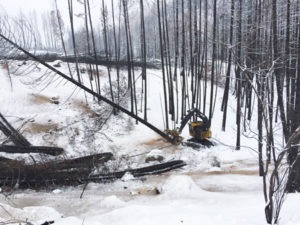

By Michael Howell
The Bitterroot National Forest is moving forward with a hazard tree removal and fire salvage project within the Roaring Lion drainage southwest of Hamilton. About 8,700 acres on both Forest Service and private land burned in the Roaring Lion Fire this past summer. The Forest Service had already approved a 2,300-acre Westside Management Project to do fuel reduction in the area when the fire in the Roaring Lion drainage beat them to the punch. Now they are moving quickly on a hazard tree removal and fire salvage project on 45 acres surrounding the Roaring Lion, Sawtooth and Ward Mountain Trailheads. The small project was proposed in October and approved in December under a categorical exclusion process that allows for expedited review.
The purpose of the project is to mitigate snag tree hazards to the public near trailheads and parking areas, reduce long-term hazardous fuels in the wildland urban interface, and provide raw materials for the wood products industry. All the trees are being removed using ground-based logging methods over frozen ground. The road leading to the trailheads is currently closed due to the logging project and the logging being conducted on a large amount of private land in the area.
According to Jon Garlitz, Timber Sale Administrator, the agency hopes to remove about 100 truck-loads of logs over the next two weeks. Doug Hall has a logging crew running a feller-buncher, a stork boom de-limber and a tractor/skidder on the project. Hall is working for Tricon Timber, LLC which was awarded the contract. The Douglas fir from the project is going to Tricon’s mill in St. Regis. The large diameter Ponderosa Pine is going to Pyramid Lumber’s mill at Seeley Lake where it will be made into window sashes.
The Roaring Lion Fire literally exploded across the landscape and burned like a firestorm, killing some large Ponderosa pine trees that measure up to four feet in diameter and range in age from 200 years to 400 years old.
Garlitz marveled at the giant logs stacked on the loading deck.
“This valley hasn’t seen trees this size harvested for probably a hundred years,” he said. He estimated the weight of one of the logs at about 5 tons and it was a real question as to whether it could actually be loaded on a truck with the equipment they were using.
The “clipper” at the site, which grips each tree in its mechanical claws, cutting it off at the base and laying it in a pile, can only handle a tree from 18 to 22 inches in diameter. Some of the old Ponderosa pines were twice that size.
Garlitz went over to one that was about 42 inches in diameter and counted the growth rings exposed on the butt of the log. Each ring represents a year’s growth. This tree was just over three hundred years old.
“This tree was already big when Lewis and Clark passed through,” said Garlitz.
Due to this project and several projects occurring on private lands in the area and the associated truck traffic, the road to the trailheads will probably not be re-opened to the public until spring.
Ryan Hughes, Timber Management Assistant for the Forest Service, said that due to the timing of the burn, late in the season, and the coincidence of an very bountiful pine cone production this past year, there is a good chance that the forest will recover naturally in the area. Hughes said he observed pine seeds helicoptering to the ground within days following the fire. He pointed to some of the cones on the ground in the area and picked one up, breaking it open to show the still viable seeds.
“We will come back this spring and check on it,” said Hughes. “We may watch it for a few years and if the natural regeneration isn’t occurring we may decide to come in and plant some trees.”
